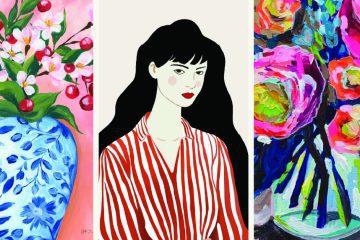Graphic design today is a whole new ballgame—and that’s a good thing. Thanks to digital tools and new tech, digital art and its impact on modern graphic design are bigger than ever. If you think it’s just about logos and posters, think again! Web design, social media, you name it—these days, designers are all over it. How about digital art? All those stunning graphics rely on it as their secret ingredient. Contemporary graphic design is more than just arranging shapes and choosing a typeface; it’s a creative space where digital tools, artistic expression, and narrative all converge.
Digital Art is Changing the Way Designers Work
Now, artists don’t just use sketchbooks and paper. The digital medium is now very empty, and there are lots of things that can be done with it. These days, designers don’t just use pens and images. It uses AI, 3D models, digital drawing, and even augmented reality (AR) to make pictures that look natural and real.
The intersection of graphic design and digital art techniques is creating a whole new level of creativity. It’s no longer just about looking pretty; it’s about how the design makes you feel, how it interacts with you, and how it tells a story. Whether it’s interactive designs or AR experiences, these designs are more immersive and emotional than ever before.
Trends Shaped by Digital Art
With contemporary digital art making waves, new trends are emerging left and right. These are the ones to watch:
- Geometric and 3D designs: All sorts of things, from stylish websites to fantastic product advertising, use 3D designs because they give a sense of depth and realism that flat designs lack.
- Art Made by AI: The use of artificial intelligence isn’t limited to machines! Using AI, designers are able to do things like develop ideas, choose color palettes, and brainstorm. The process is being accelerated and design is becoming more efficient as a result.
- Vibrant fonts and illustrations: No longer are words merely words. To make messages more engaging, designers are combining pictures with typefaces, transforming text into full-on art.
- Miniature Animations & Motion: Motion adds a whole new level of immersion to contemporary design, whether it’s through scrolling effects or moving icons.
So, when we say how contemporary digital art informs graphic design trends, we’re not talking about something in the background anymore. It’s the headline act.
Check Out: The Fusion of Traditional and Digital Techniques: Teresa Cowley’s Graphic Design Mastery
The Impact of Digital Tools on Graphic Design
The role of digital tools in contemporary graphic design is what changes everything. Design professionals now use these tools in a whole new way. Things that used to take days or weeks can now be finished in hours. Designers can draw, try different things, and make changes right away. The best part? The quality keeps getting better. Digital tools speed up the process, give you more options, and let you be much more artistic, whether you like to sketch, make prototypes, or play around with 3D elements.
How Artists and Designers Are Teaming Up
The cool thing is that graphic designers and digital artists are no longer separate types of artists. Now, artists who know a lot about AI, animation, UI/UX, and even drawing are working together to make amazing things. With this mix of skills, designs become more alive and engaging. Think about digital signs that change based on who sees them or websites that change based on how people move around on them. There are a lot of options.
Adding Emotion to Design
It’s not all about the aesthetics. Digital art is about bringing emotions to the table. Ever visited a website where the background changes as you move your cursor? Or how about an animated character guiding you through an app? These elements add an emotional layer to the design that goes beyond visuals. They connect with the user on a deeper level, and that’s exactly what today’s audiences are craving.
Sustainable Digital Design
Digital art is getting a lot of attention because so many brands are trying to be more eco-friendly. When you can make fully immersive digital experiences, why print out big billboards or put up huge installations? Virtual stores, augmented reality brand launches, and even NFT art are all getting money from brands. This is pushing the future of digital art in graphic design projects to be both new and long-lasting.
The Future of Digital Art in Graphic Design
So, what’s next for digital art in graphic design projects? To be honest, it looks pretty exciting. More and more, AI and humans will work together, combining imagination and technology in fun new ways, as technology keeps getting better. AR/VR experiences that break the rules of design come to mind, as well as art that changes based on who is looking at it at any given time. The future of design isn’t just about making things look good; it’s about making them feel right, too—whether you’re using your phone or computer or stepping into a virtual space. It’s all about creating experiences that engage us on a deeper level.
Final Thoughts
No one can deny the influence of digital art on contemporary graphic design, and, to be honest, who would want to? It’s opening up new possibilities, encouraging innovation, and providing designers with a fresh channel for audience engagement.
Modern graphic design isn’t just about simple layouts and color schemes anymore. It’s also about making people feel things, getting them involved, and sharing stories. The options are already exciting, and they will only get better as time goes on and technology and methods improve. They have them here, and they are full of promise!
Frequently Asked Questions
- What are some contemporary art styles influencing graphic design today?
Modern graphic design is increasingly shaped by styles like abstract expressionism, minimalism, surrealism, glitch art, and art made by AI. Branding, ads, and digital material all look better with these new artistic styles.
- How does digital technology allow contemporary art and graphic design to merge?
Thanks to AI-powered design platforms, digital painting software, and 3D modeling software, graphic designers can use modern art methods in their work. This makes visuals more dynamic and open to new ideas.



0 Comments